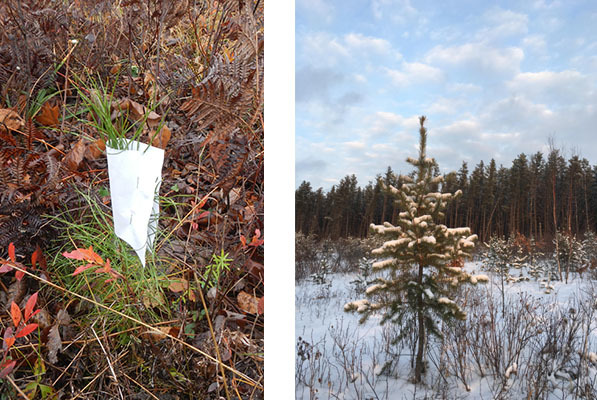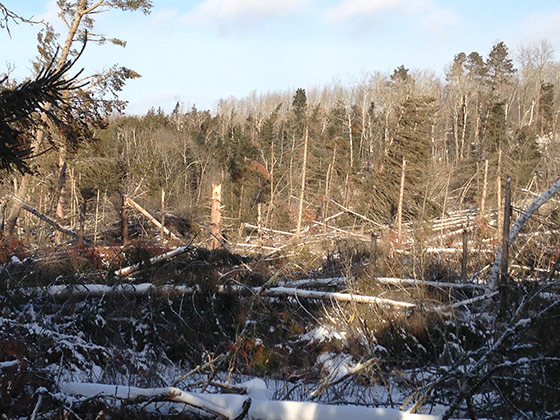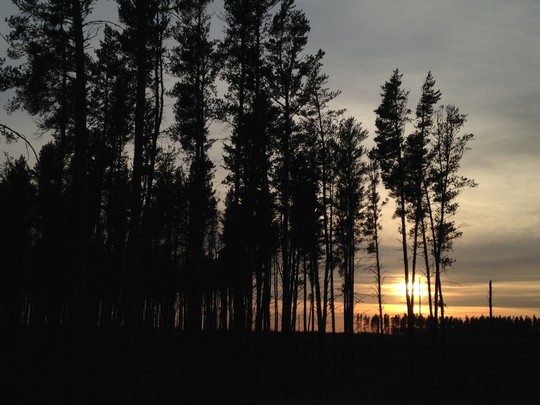|
“Nature gives to every time and season some beauties of its own; and from morning to night, as from the cradle to the grave, is but a succession of changes so gentle and easy, that we can scarcely mark their progress.”
Charles Dickens – The Life and Adventures of Nicholas Nickleby
Sometimes Succession is Not so Easy
Fifth in a 50th anniversary story series highlighting natural features preserved on Minnesota Scientific and Natural Areas.
Alaina Berger, Minnesota Biological Survey
Succession – Have you ever said to yourself that this place seems different from when you were a child? You remember that large old gnarly oak tree with its spreading canopy, and now that it has been gone awhile after the big windstorm, a huge thicket of shrubs has taken its place. This change is called succession and can be seen by keen observers as the changes in presence and relative abundance of plant species over time. In last Spring’s 2019 Nature Notes, the ways that plants and other organisms evolve over long periods of time to emerge as a Native Plant Community (NPC) is described. Successional change within NPCs is studied by ecologists by examining data such as historic pollen and tree survey data and plant survey work conducted by the Minnesota Biological Survey. Through painstaking analysis, a model of how plant communities function given various types of natural disturbance is developed. Nothing is static even though we may experience natural places like a snapshot in time.
 |
Left: Capped jack pine seedling at La Salle Lake SNA. Capping is meant to reduce deer browsing. Photo by Tyler Janke. Right: Jack pine regeneration at Badoura Jack Pine Woodland SNA. Photo by Kelly Randall.
Climate change and human impacts – Landscape change due to human influence and climate change significantly alter succession. Wildfires are now largely controlled and development of land creates novel site conditions, often favoring invasive species. The frequency of this change has been increasing and putting plant communities on unique trajectories. The Scientific and Natural Areas Program protects unique and intact plant communities in the face of these threats. It is important to set aside the land that support Native Plant Communities and to maintain the processes that shape the communities. Sustaining the functional integrity of the Native Plant Communities within Scientific and Natural Areas (SNAs) depends on understanding the successional processes at play as well as the composition and structure of the communities.
Complex interactions – It is tempting to see succession as a single, closed loop that endlessly cycles. Realistically many interacting factors cause the successional path of a plant community to diverge. The scale and intensity of disturbances can leave legacy features that influence the future composition of a community. At a small scale, it is likely that local site conditions will filter out plants that will not succeed based on moisture and nutrients available. In some cases the plants themselves change the site, creating shade or dropping leaf litter to build soil nutrients. Species adapted to fire use a pulse of nutrients and thrive in open conditions. Wildfire can be catastrophic– reaching the tree canopy and opening large areas. When wildfires remain at the ground layer, only subcanopy vegetation is impacted. Wildfire on both levels tends to burn the surface of the soil and duff layers, releasing nutrients and creating mineral seedbeds for light loving species. In contrast, wind events leave the ground vegetation intact. Factors driving succession are complex but often organized by: site condition as influenced by topography and past disturbances, species availability either through seed or established seedlings, and species competitiveness at acquiring light, moisture, nutrients, and resisting animal herbivory.
 |
Prescribed burns mimic wildfire conditions needed by fire dependent plant communities. Photo by John Gregor. ©ColdSnap Photography.
Challenges to sustaining ecosystem processes – In our modern time of fire suppression, maintaining processes typical for fire dependent SNAs can be challenging when the momentum of the plant community is towards shade loving and fire resistant species. For example, in the La Salle Lake Scientific and Natural Area, a windstorm in 2012 blew down mature jack pine within this Central Rich Dry Pine Woodland Community. The mature successional stage representing this community is very rare on the landscape as surface fires needed to maintain seedbed and light conditions are no longer occurring on a regular interval. In this community, surface fires occurred on about a 30-year rotation, keeping quaking aspen, and shrub species from forming dense colonies, thus maintaining an open woodland canopy. These open woodlands historically supported prairie grasses such as big and little bluestem that coexisted with jack pine, the dominant fire tolerant tree. The windstorm of 2012 favored hazel and aspen making it difficult for the woodland to reset to an early successional stage. Work to reintroduce young jack pine as a dominant tree means recreating the open seedbed conditions that fire once created.
 |
Blow down area at La Salle Lake SNA, east of LaSalle Creek. Photo by Kelly Randall.
What we can do to keep succeeding – There is never time to take a break when protecting natural features with exceptional scientific or educational value. Natural disturbance based techniques that consider the frequency and intensity of historic natural disturbance were used at La Salle Lake SNA. They were designed to mimic conditions created by wildfire—removing dead trees, opening the canopy while leaving remaining mature trees to serve as seed sources. In addition, planting seedlings was deemed necessary to encourage the successful regeneration of jack pine. Removing invasives and encroaching shrubs will be critical to reducing competition and mimics the burning of undergrowth. If these techniques are successful, the functional processes will be intact and the native plant community will thrive.

Site Highlight: Badoura Jack Pine Woodland SNA
Tyler Janke, SNA Region 1 Specialist
The Badoura Jack Pine Woodland Scientific and Natural Area (SNA) is located in north-central Minnesota, approximately 20 miles southeast of Park Rapids. This 908 acre SNA was acquired in 2014 and is open to the public for nature observation, education and research activities. Additionally, hunting, trapping and berry picking are allowed at the site.
This SNA supports one of the largest remaining blocks of native jack pine woodland in the region. Although once widespread and common, jack pine woodlands in this area have precipitously declined over the past few decades as a result of clearing for agriculture and timber harvest followed by conversion to pine plantations. Today, jack pine woodlands larger than 40 acres are considered uncommon, and stands larger than 100 acres are considered rare.
The Badoura Jack Pine Woodland SNA consists of about 390 acres of mature jack pine – yarrow woodland (approx. 60 years old), 440 acres of young jack pine woodland, and roughly 80 acres of red pine plantation. This native plant community (classified as FDc23a) is listed as critically imperiled in Minnesota, and globally rare. The jack pine woodlands in this region are unique, characterized by a race of jack pine with “open cones” and ground layer vegetation comprised of a mix of prairie and northern forest species. Generally, jack pine cones are tightly sealed with resin until heat from fires opens the “serotinous” cones and releases the seeds. However, the jack pine trees found in this SNA have adapted to more frequent, but less intense fires, and will often open their cones to release seeds on hot summer days. This composition appears to be a legacy of patterns of vegetation present several thousand years ago when prairie covered a substantial part of north-central Minnesota. It’s not uncommon to see species more typical of prairies, like hoary puccoon, rough blazing star and prairie phlox growing side by side with northern forest plants such as low bush blueberry, stemless lady’s slipper and tessellated rattlesnake plantain. Additionally, several populations of Hill’s thistle (Cirsium hillii), a state special concern species, occur at the site.
|
 |
Mature jack pines at Badoura Jack Pine Woodland SNA. Photo by Kelly Randall.
Prior to DNR purchase as an SNA, the land was owned by the Potlatch Corporation and managed for commercial timber production. The young woodland areas were stands logged between 2007 and 2012. Although recently harvested, their native ground layer vegetation remains intact, and jack pine is successfully re-establishing. The mature woodland areas on the site today date to 1959, when an intense wildfire burned nearly all of what became the SNA. The 1959 fire killed the majority of woodland on the site, but also provided optimum conditions for jack pine seeds to germinate and seedlings to grow. This reliance on fire for maintenance and self-renewal showcases how the woodlands at the SNA are fire-dependent systems.
Management of the site today is largely focused on:
- Maintaining the species composition and structure of the jack pine woodlands.
- Supporting stable populations of rare species and other species in conservation need (SGCN).
- Supporting research and learning opportunities related to the ecological management of jack pine dominated communities.
- SNA managers are also actively working on prescribed fire plans with the goal of reintroducing low intensity surface fire to the site.
SNA Events
Seasons change yet again! There are still plenty of opportunities on the SNA Events Calendar to get out and enjoy some wonderful fall colors. There are volunteering events for National Public Lands Day, seed collections, educational events, hikes and more. Here is a quick highlight of some of the events coming up, check the website for a more complete list.

Notes from Site Stewards
Site stewards monitor SNAs across Minnesota. Their observations provide valuable information to the SNA Program. Here are some interesting notes from recent reports.
Prairie lilies (Lilium philadelphicum) at Kasota Prairie SNA. Photo courtesy of Denise Friesen and Steve Gahm.
- On June 30th, site stewards Denise Friesen and Steve Gahm visited Kasota Prairie SNA and enjoyed the summer blooms. In a note to the site managers, they said “The Prairie thanks you for the burns and other work! We were at the prairie this past weekend and were amazed at the amount of prairie lilies. I counted about 30 blooms and buds. One plant had 5 blooms on it.”
- Site steward George Minerich has seen many visitors enjoying Iona’s Beach SNA on the North Shore of Lake Superior this summer. On July 22nd, he noticed that some visitors were picking up trash they found on beach. The beach was very busy on August 31st, with around 37 visitors, including many families and 6 kayaks on the big lake.
- Gina Cherny, the new site steward of King’s and Queen’s Bluff SNA, led the first of her monthly interpretive hikes at the SNA on August 10th. Nine people attended the hike out to King’s Bluff to enjoy native wildflowers, bluff prairies, and spectacular views of Queens Bluff and the river valley beyond.
- On September 8th, 16 students from the North Dakota State University Natural Resources Management Club surveyed transects along the newest addition at Felton Prairie SNA, the Dakota Skipper unit. The club became the official site stewards of the Dakota Skipper unit this summer, and are working with SNA staff to do an invasive species mapping project using reporting tools such as iNaturalist and EDDMapS.
Thanks for all the work you do, SNA stewards!

|